Five Reasons Swimming Lessons will Change Your Child’s Life (For the Better)
Learning to swim is a valuable life skill that could potentially save your child’s life. Learning to swim will also build resilience in your child and help them succeed in life! There are many ways that swimming builds resilience. We’ve listed a few of our favorites below:
1. Facing and overcoming fear:
Learning to swim often involves overcoming the fear of water. Many children initially feel anxious or scared when they start swimming lessons, especially if they have had limited or traumatic exposure to water. Overcoming this fear teaches them how to manage their emotions and face challenges head-on. When students are initially fearful, we usually see dramatic changes in the first 3-5 lessons. If your first few lessons are tough, hang in there, your child will overcome their fear and begin to soar!
2. Developing confidence:
Children gain confidence in their abilities as they become proficient swimmers. This newfound confidence can spill over into other areas of their lives, helping them approach new challenges with a positive attitude and self-assurance.
3. Building physical resilience:
Swimming is a physically demanding activity that can help children develop strength, stamina, and endurance. Regular practice can improve their physical fitness, which, in turn, can enhance their overall resilience to illness and injury.
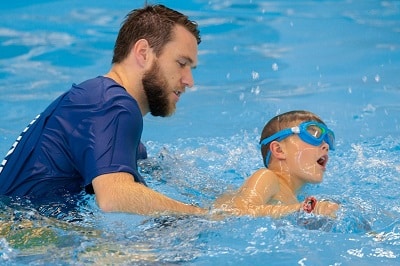
4. Learning persistence and patience:
Swimming is a skill that takes time and practice to master. Children learn the importance of persistence and patience as they work on their swimming techniques. They understand that improvement often comes gradually and that setbacks are a natural part of the learning process.

5. Developing problem-solving skills and increasing adaptability:
Swimming requires children to solve various problems, such as how to maintain buoyancy, coordinate their movements, and breathe effectively in the water. In survival swimming lessons, we focus on helping children problem-solve hypothetical emergencies.
Children will also be exposed to various instructors and water conditions in the pool. These problem-solving skills can be transferred to other areas of life, helping children become better at finding solutions and adapting when faced with challenges or new situations.
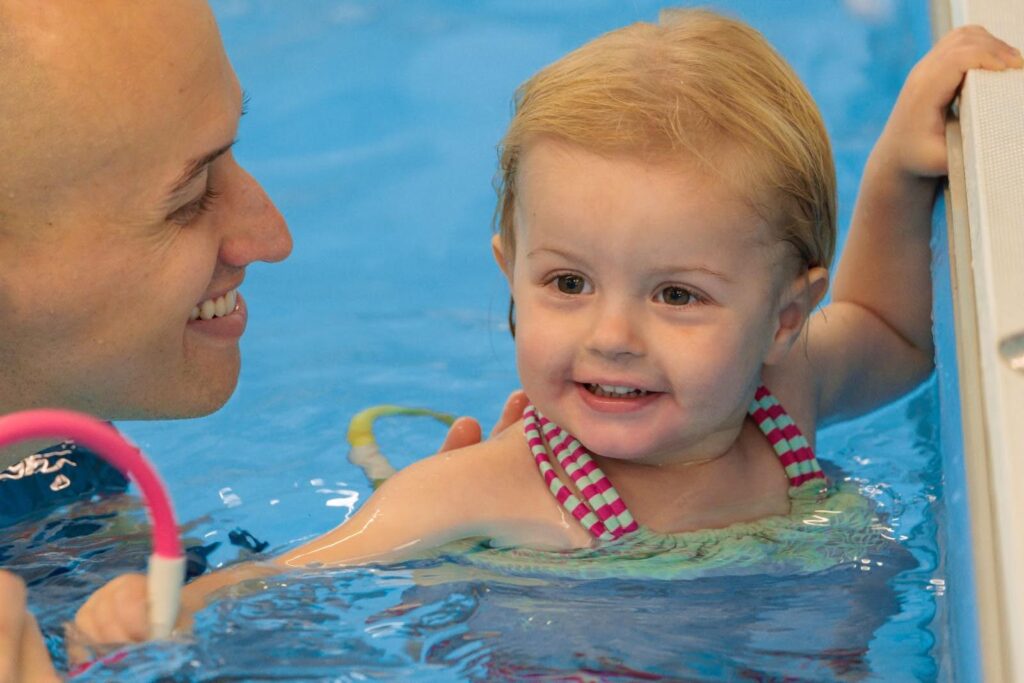
Learning to swim WILL build resilience and confidence in your children! View our flexible scheduling options at www.swimkidsutah.com. We recommend starting with a fast track to quickly get through the difficult lessons and build confidence in 1-2 weeks instead of years or months!
Ready to dive into fun? If you’re in Davis, Salt Lake, or Utah Counties, secure your child’s spot at SwimKids now! Click here to register and make a splash today!
Five Reasons Swimming Lessons will Change Your Child’s Life (For the Better)
4 Months-6 Months
Babies usually enjoy the water at this age! Although, their swimming reflexes may be doing most of the work.
At this age, they can typically hold their breath and learn to lie down in a floating position.
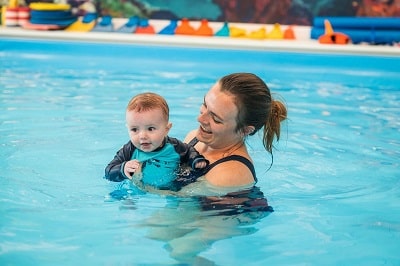
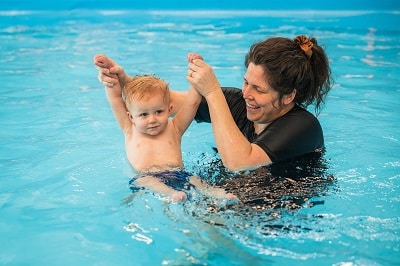
6 Months- 18 Months old
During this time your baby’s natural swimming reflexes will disappear. Some of the things they were reflexively doing before will need to become learned skills. This is great for their brain development!
At this age, they are capable of floating on their own, holding their breath underwater, and turning underwater to grab and hold onto the wall.
18 Months- 36 Months Old
During this time your child will experience a lot of growth in and out of the water! Their separation anxiety will gradually start to go away and with consistent lessons, they will become more comfortable in the water.
At this age, they are capable of kicking, rolling on their back to float, and then turning to swim again. As they practice and improve they will be able to do this multiple times to make it across the pool.
3 Years - 5 Years old
What a fun age! During this time, your child may develop more of an understanding of the world around them. This may lead to them being more cautious or fearful of situations that were previously easy. This is part of normal development and with repetition in lessons, your child will learn to master their anxiety/fear!
At this age, students may be ready for group classes where they can learn social swimming, gain more independence and confidence in the water, and build endurance. They are also ready to start learning to use their arms and other stroke basics.
5 Years +
At or around five years old your child should have the necessary coordination to put the strokes together. Swim-float-swim and the stroke basics learned at an earlier age will make this transition natural.
At this age, students are ready to learn freestyle, backstroke, breaststroke, butterfly and flip turns! We recommend private lessons to learn the strokes and group lessons to practice and refine them!
Ready to dive into fun? If you’re in Davis, Salt Lake, or Utah Counties, secure your child’s spot at SwimKids now! Click here to register and make a splash today!
Water Safety Benchmarks for Children: Age-Specific Guide
Parent-Tot Swimming Lessons:
Parent-tot lessons are designed for younger children, typically between 4 months to 2 years old, accompanied by a parent or other caregiver.
These lessons are an introduction to water safety, including floating and breath control.
Parent-tot lessons would be a great fit for your child if:
- Your child can hold his head up on his own.
- Your child is between 4 and 28 months old.
- You want to join your child in the water.
- You want to get a jump start on water safety and brain development.
- You want to prepare your child for private instruction
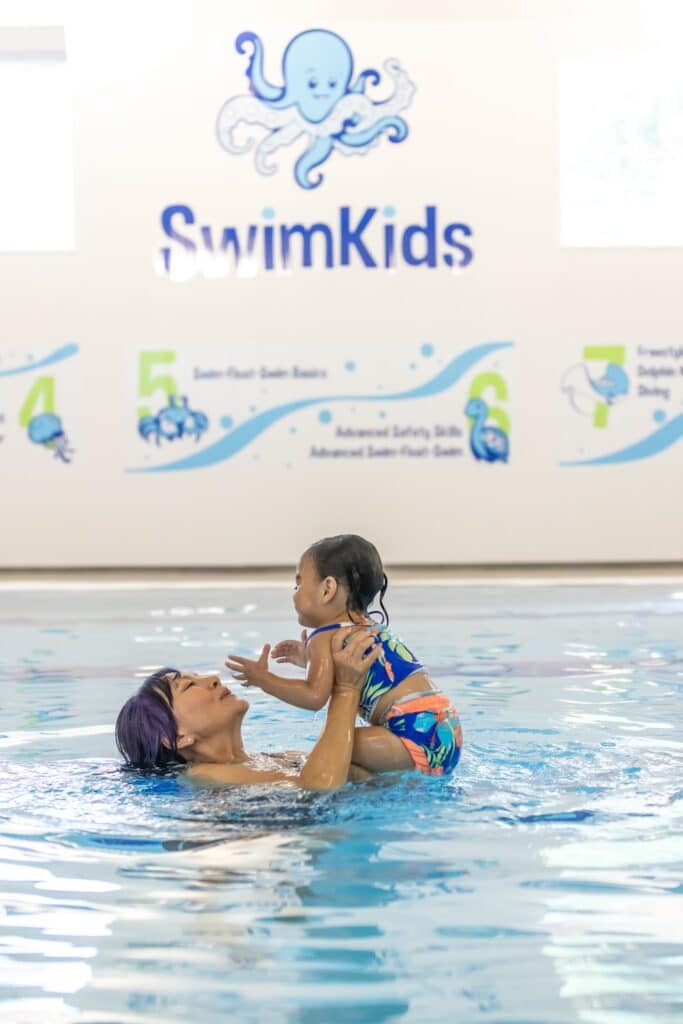

Parent-tot lessons offer an opportunity for parents or caregivers to bond with their child in a water environment. The focus is on introducing water play, basic movements, and developing trust between the child and their caregiver. It helps young children become comfortable with water and prepares them for private swimming lessons as they grow and acclimate to the water.
Private Swimming Lessons:
Private lessons offer one-on-one instruction between the swimmer and the instructor. This personalized attention allows the student to progress quickly and master water safety and survival skills. We offer private lessons in three different formats: weekly recurring, fast track, and punch pass.
We recommend private instruction for all children 24 months + who cannot swim on their own.
Private Recurring:
- You can come on the same day and time every week.
- Your child is ready to learn strokes.
- Your child is comfortable in the water.
- You want to maintain your child’s skills as they grow.
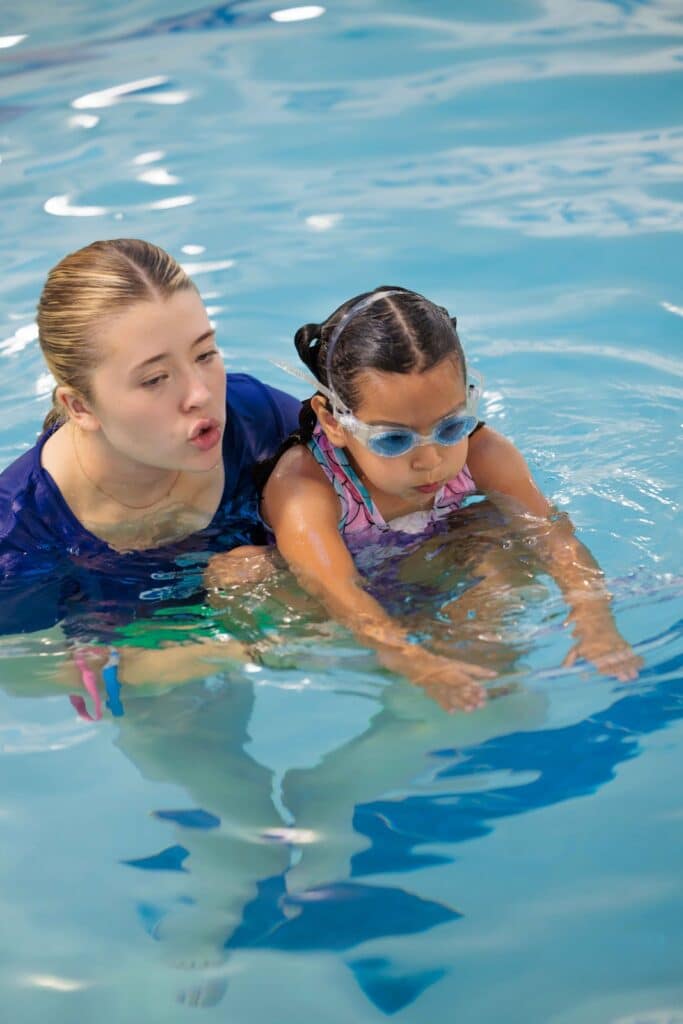
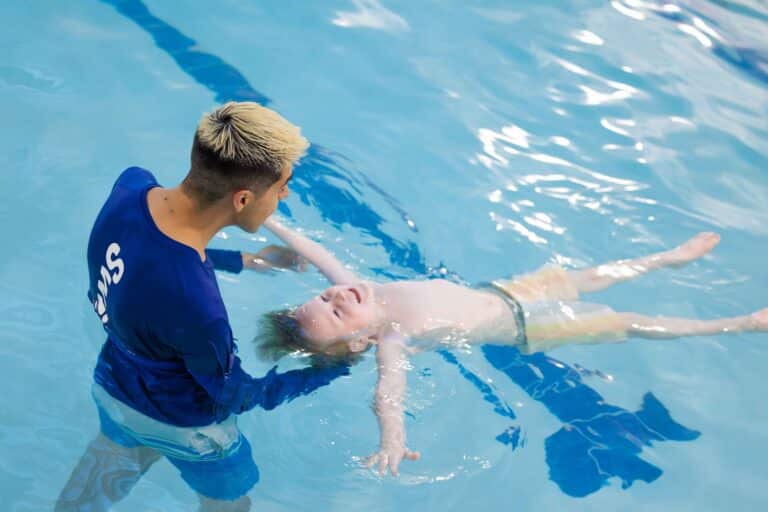
Fast Track:
- Your child is four or younger OR your child is new to swimming.
- You or your child are afraid of the water.
- You are preparing for a vacation or summer swimming.
- Your child is still learning basic safety skills.
Punch Pass
- You want to supplement your child’s regularly scheduled lessons.
- You cannot come at a consistent day and time every week.
- Your child is adaptable to swimming with multiple instructors.
For best results, we recommend starting with 1-2 fast track sessions and then transitioning to weekly recurring lessons. If you can’t make a fast-track session work, weekly recurring lessons are still an option. We recommend punch-pass classes for those who don’t have a consistent schedule or want to supplement their regular lessons as time allows.
Group Swimming Lessons:
Group lessons are an important part of your child’s water safety training. Once your child can comfortably swim across the pool on their own, they ready to join a group class. Our group classes focus on endurance, water safety skills, social swimming, and stroke development. Learning to interact safely with other children in the water is an important life skill and a stepping stone to safely enjoying the water outside of swimming lessons.
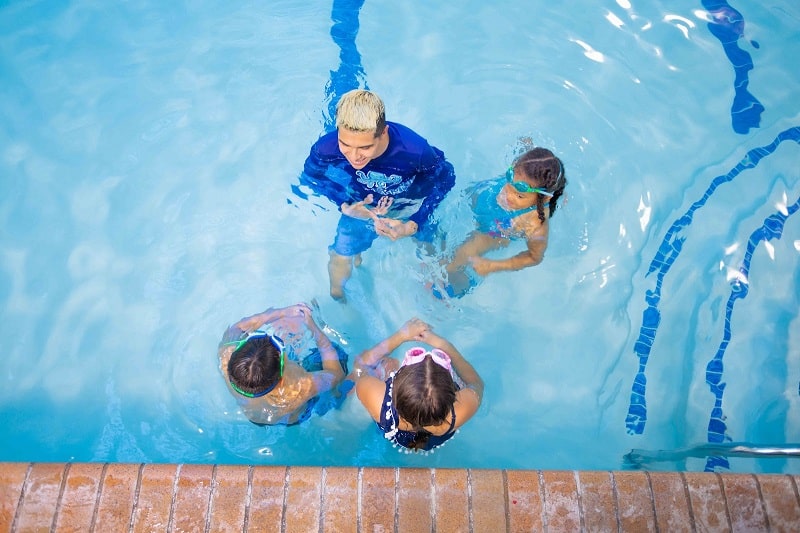
Your child is ready to join a group class if:
- Your child can comfortably and independently swim across the pool unassisted.
- You want your child to build endurance in a longer class.
- You want your child to learn social swimming skills.
- You want your child to become more comfortable swimming independently outside of swimming lessons.
Ready to dive into fun? If you’re in Davis, Salt Lake, or Utah Counties, secure your child’s spot at SwimKids now! Click here to register and make a splash today!
How to Choose the Best Lessons For Your Child
Did you know that babies are born with natural swimming and self-rescue skills? Below are some of the reflexes we know about:
Dive Reflex (Bradycardic Response):
The dive reflex causes a baby’s heart rate to slow down when their face is exposed to water. This typically starts to diminish around 6 months of age. By the time they are a year old, this reflex tends to be less prominent.
Swimming Reflex (Swimming or Paddling Reflex):
The swimming reflex is when babies instinctively move their arms and legs in a swimming or paddling motion when placed face down in water. It usually starts to fade around 4-6 months of age. As they gain more control over their movements, this reflex becomes less pronounced.
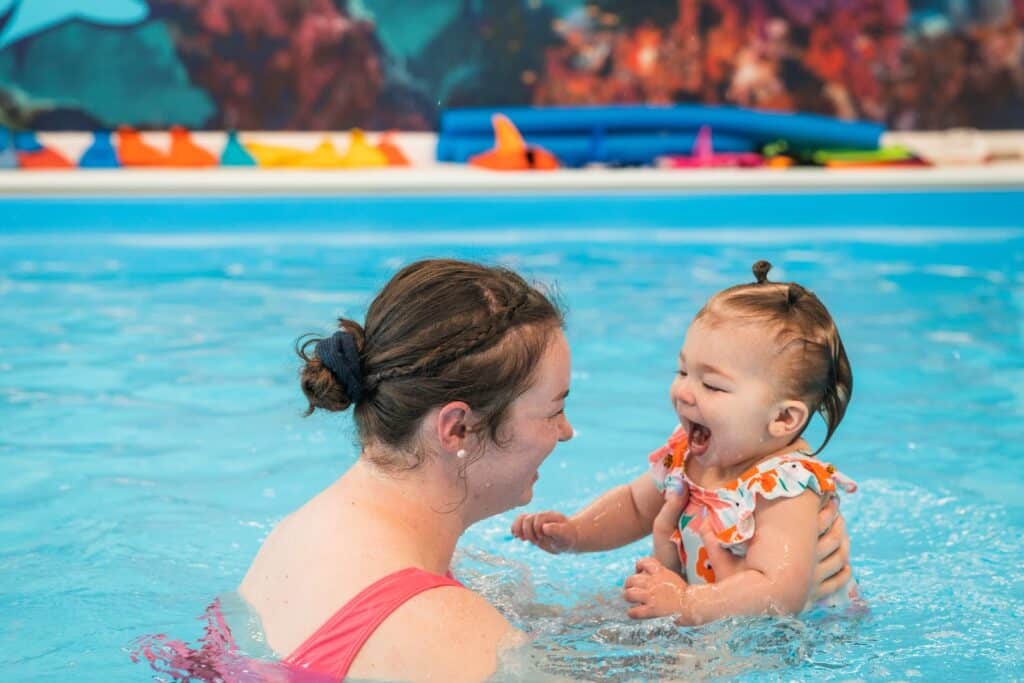
Gag Reflex:
The gag reflex helps prevent choking when water enters the baby’s airway and it remains throughout life. It is a protective response that continues to be present in children and adults.
Moro Reflex (Startle Reflex):
The Moro reflex consists of the baby extending their arms and legs in response to a sudden change in position or stimulus. It tends to disappear around 3-6 months of age as babies develop better control over their movements.

These reflexes do not translate into swimming skills or babies being safe in and around water, but they may help you explain changes in your baby in the water around six months old. Learning proper swimming techniques from qualified instructors is crucial for water safety for infants and children.
Remember that adult supervision is always essential when babies or young children are in or near water, regardless of their reflexes or swimming abilities.
Ready to dive into fun? If you’re in Davis, Salt Lake, or Utah Counties, secure your child’s spot at SwimKids now! Click here to register and make a splash today!
Baby Swimming Reflexes: Everything You Need to Know About Their Innate Skills
- Children should wait 30 minutes to an hour after eating before starting lessons.
- Children should wait one to two hours after having a bottle of milk or other dairy products before starting lessons.
- If your child is hungry before lessons a light snack of simple carbs- crackers, bread, or dry cereal is best.
- Please make sure your child is well hydrated before lessons and stops drinking water about 30 minutes before lessons. Drinking a lot right before lessons can give children stomach cramps or they may have to get out and use the restroom during lessons.
- If your child isn’t feeling well, please reschedule your lesson!
- Each child is different, and you know your child best! These tips can be a helpful starting point, but be sure to monitor your child and adjust as needed.
Ready to dive into fun? If you’re in Davis, Salt Lake, or Utah Counties, secure your child’s spot at SwimKids now! Click here to register and make a splash today!
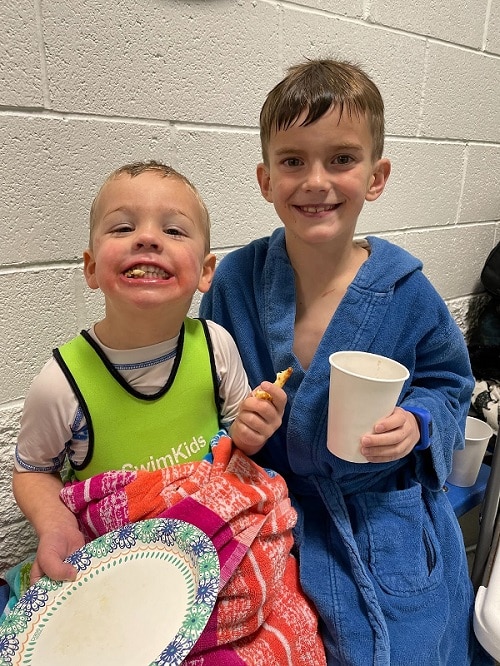
What to Know About Eating Before Swimming Lessons:
Some children may be initially apprehensive or fearful of being in the water. Overcoming this fear and building confidence in the water can take time and patience from the instructor, parent, and child. Here are some things you can do to make your child’s lessons a success:
- Be consistent. Come to every lesson and arrive at least five minutes early.
- Make sure your child uses the restroom right before lessons.
- If your child doesn’t want to get into the water, ask for help from your instructor.
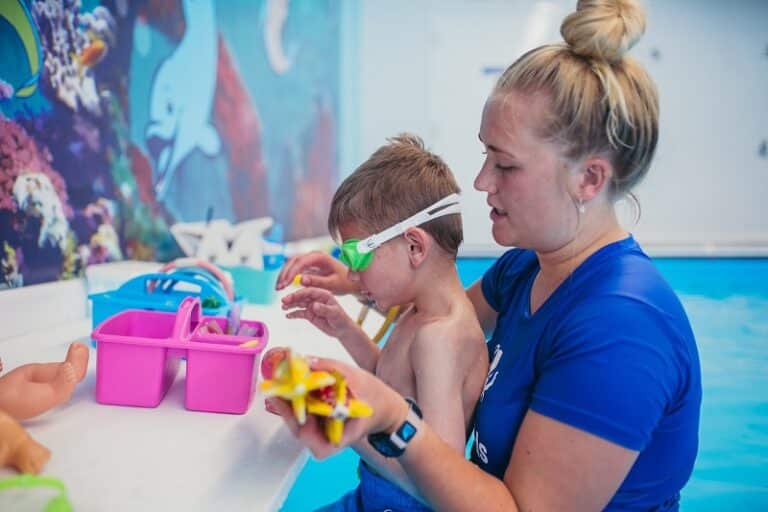

- Celebrate your child’s progress with our stamps and stickers!
- Watch other children swimming before lessons.
- Watch our fast-track videos between lessons.
- Film your child swimming and watch it after lessons together.
- Cheer for your child during lessons.
- Focus on what is going well and express that to your child during and after lessons. E.g. “Good job floating,” “I like how you are listening to your teacher,” and “I saw you were getting better at putting your face in the water today.”
- Remind your child that he can do hard things! “When we work at things they get easier!” “Even though floating is hard for you, I saw you listening and trying your best!”
- Pick out a swim toy or other reward your child can work towards earning once she is happy in lessons.
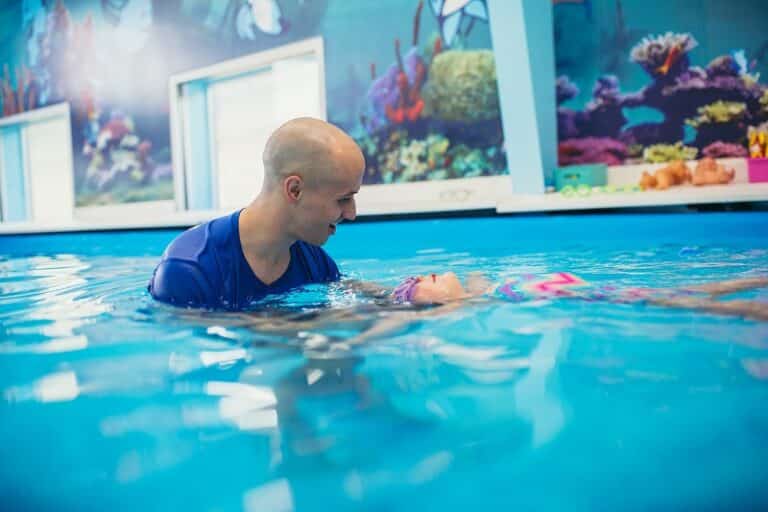
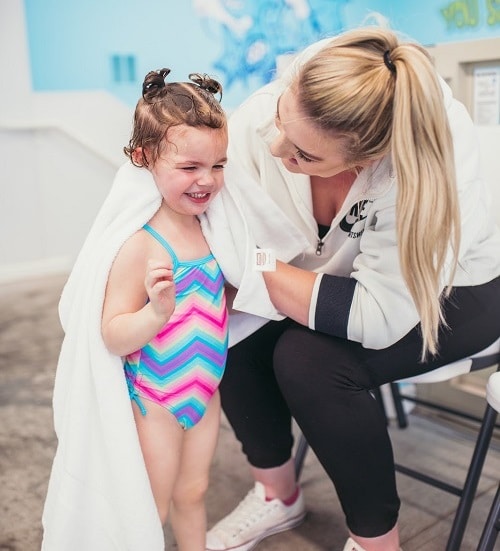
We see the best progress in children when their parents are consistent. When a child is fearful, continuing to bring him to lessons will help him overcome his fears! Most students will quit crying between lessons three and five. If your child is under the age of five or fearful of the water, we recommend beginning with a fast track. This will help get through the difficult lessons more quickly and master the basic safety skills at a faster pace.
Ready to dive into fun? If you’re in Davis, Salt Lake, or Utah Counties, secure your child’s spot at SwimKids now! Click here to register and make a splash today!
How to Help Your Child Succeed in Swimming Lessons!
Water Safety
Year-round swimming lessons are the best way to keep your child strong and happy in the water! Consistent exposure to lessons helps children’s skills to continue to grow with their bodies. Ensuring your child is a proficient swimmer- is a lifelong gift! Most children will naturally retain the majority of what they learn year after year.
However, as their bodies and cognitive skills change, having refresher lessons is ideal. Their skills will increase more naturally if they consistently attend their lessons at least once a week. Increased exposure to the water can significantly reduce the risk of drowning. This will allow your family to safely enjoy water activities at home or abroad throughout the year!
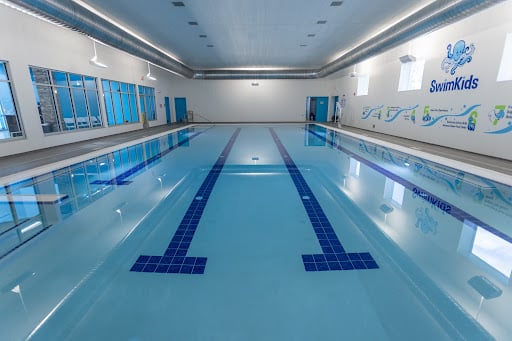
Physical Fitness
Our indoor swimming pools allow us to provide a consistent environment for learning and exercise all year long. Our pools are kept at a toasty 90 degrees and are comfortable regardless of the weather outside. Swimming is a low-impact, full-body workout that engages multiple muscle groups. This enhances strength, endurance, and cardiovascular health without putting stress on joints!
Seasonal Pricing
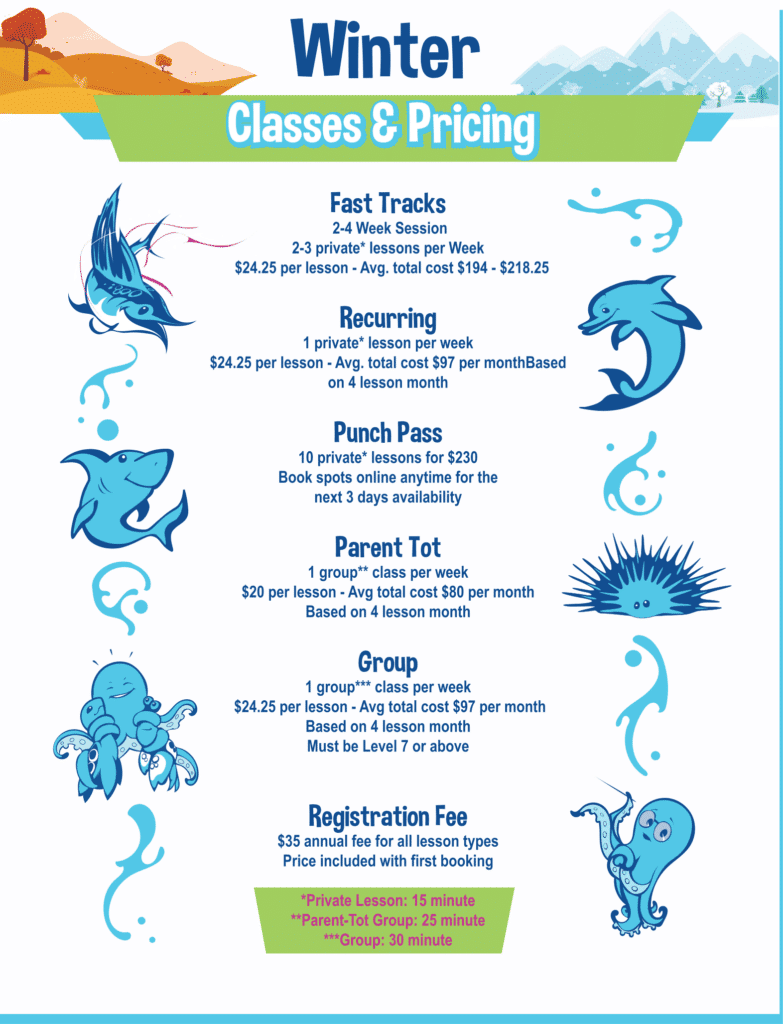
Because of lower demand in the fall and winter months, we are able to offer a discount on lessons. Take advantage of fewer people in the pool and lower prices by swimming year-round!
Ready to dive into fun? If you’re in Davis, Salt Lake, or Utah Counties, secure your child’s spot at SwimKids now! Click here to register and make a splash today!
What Are The Benefits Of Swimming Year-round?
What are Puddle Jumpers?
Puddle jumpers have become a popular flotation device for children when swimming or playing in the water. However, while they may seem like a convenient way to keep children safe, they can actually be quite dangerous.
Puddle jumpers are essentially flotation devices that are worn on a child’s arms, chest, or both. They are designed to keep a child afloat in the water and prevent them from sinking or drowning. Here are some reasons we don’t recommend using puddle jumpers.
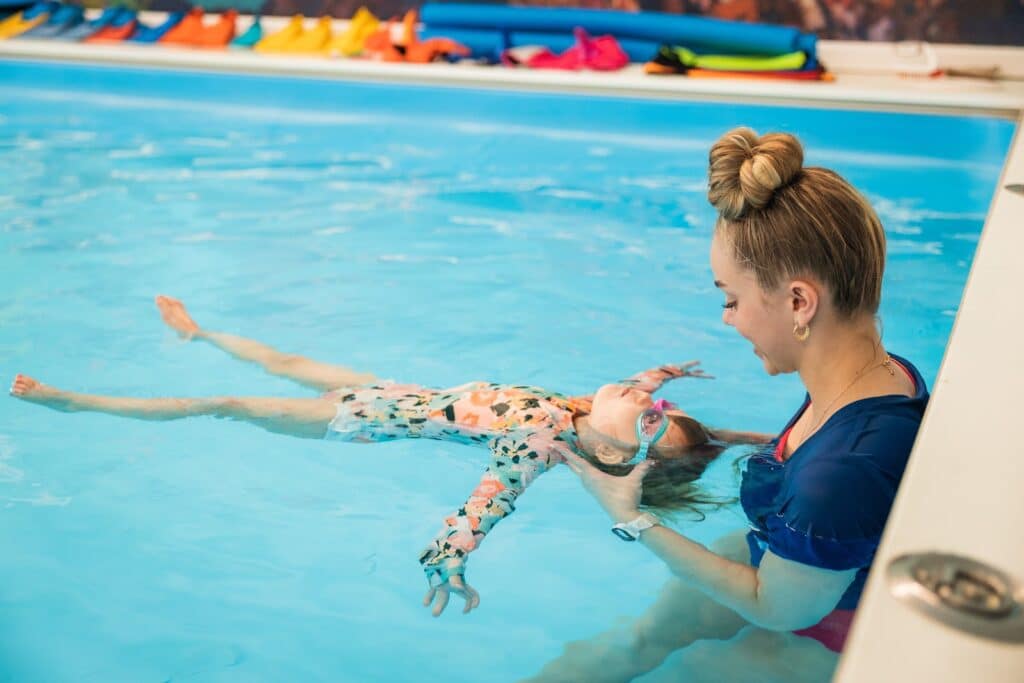
False Sense of Security:
Children who wear puddle jumpers may think that they will always be safe in the water, even if they do not know how to swim. This false sense of security can lead to children seeking out and getting into water unsupervised and without the skills to self rescue. When a child experiences swimming pools without a floatation device, they learn what their body is and is not capable of. This experience helps develop a healthy respect for the water.
Puddle jumpers can also give parents a false sense of security. Parents may think that their child is safe as long as they are wearing a puddle jumper, but this is not always the case. In fact, parents who rely too heavily on puddle jumpers may not be paying enough attention to their child’s behavior in the water.
Puddle jumpers can also be unreliable. If a puddle jumper is not properly secured or is too loose, it can easily slip off a child’s arms or body. This can happen if the puddle jumper is not the right size for the child, or if it is not properly adjusted. In some cases, a puddle jumper can even come apart in the water, which can be very dangerous for a child who is relying on it to stay afloat.
Interfere with Learning to Swim:
Children who use puddle jumpers may not be as motivated to learn how to swim, as they may feel that they do not need to. This can delay a child’s progress in the water and can even make them more fearful of swimming without a flotation device.
Puddle jumpers can restrict a child’s movement in the water. Puddle jumpers are designed to keep a child’s head above water, but they can also make it more difficult for a child to move their arms and legs freely. This can make it harder for a child to learn proper swimming techniques and can actually increase their risk of drowning. The buoyancy of the puddle jumper also prevents children from building the muscle strength and lung capacity needed to swim on their own.
The biggest barrier puddle jumpers impose on learning to swim, is that they force children into an upright position- also known as the drowning position. Children who wear puddle jumpers will default to an upright position in the water rather than the horizontal position that is needed to swim and float. It is especially important not to put your child in flotation devices when they are learning to swim or have learned to swim. This will interfere with their swimming or force them to swim in the incorrect position.
Conclusion:
While puddle jumpers may seem like a convenient way to keep children safe in the water, they can actually be quite dangerous. They can create a false sense of security and interfere with a child’s ability to learn how to swim. If parents want to keep their children safe in the water, they should invest in swimming lessons and always supervise their children closely while they are swimming or playing in the water. Children who are taught to swim at a young age are more likely to be comfortable and confident in the water, which can help keep them safe throughout their lives.
Ready to dive into fun? If you’re in Davis, Salt Lake, or Utah Counties, secure your child’s spot at SwimKids now! Click here to register and make a splash today!
Puddle Jumpers 101: Why Not to Use Arm Floaties
Swimming is a fun pastime, but more importantly, an essential life skill that can save lives! When it comes to learning swimming skills, many parents wonder about the ideal age to introduce their children to formal swimming lessons.
While there isn’t a one-size-fits-all answer, experts agree that starting swimming lessons at a young age is highly beneficial. You should consider your own circumstances and how often your child is exposed to the water.
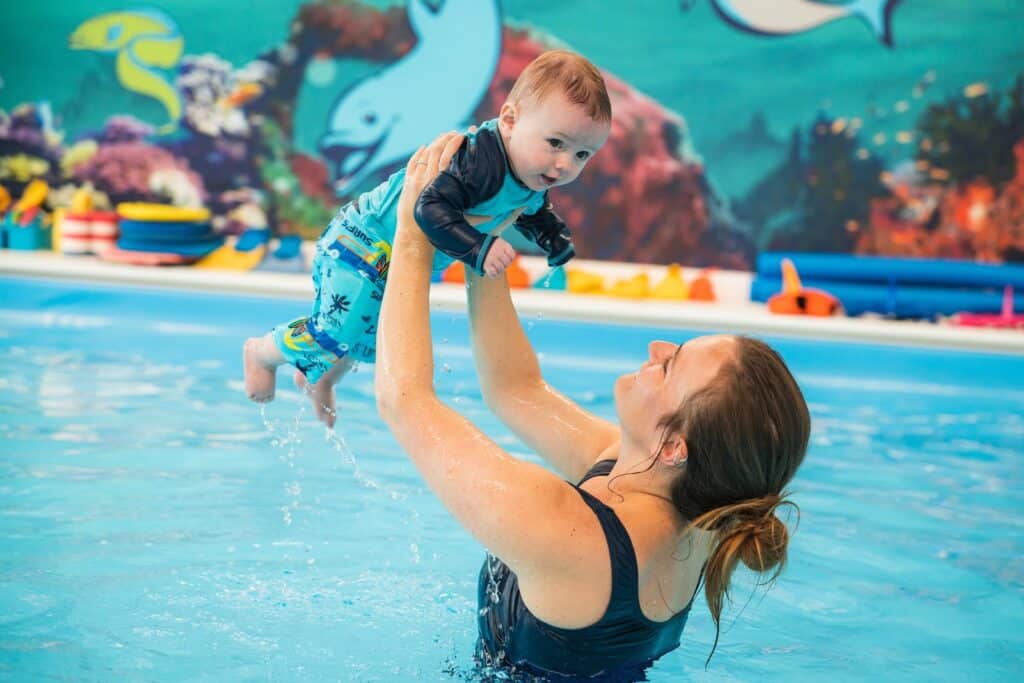
This will help you determine when and what type of lessons to choose. Although water emergencies can happen at any time, especially if you live or vacation around the water. If your child is exposed to water more frequently, you will want to get your children started in lessons as early as possible!
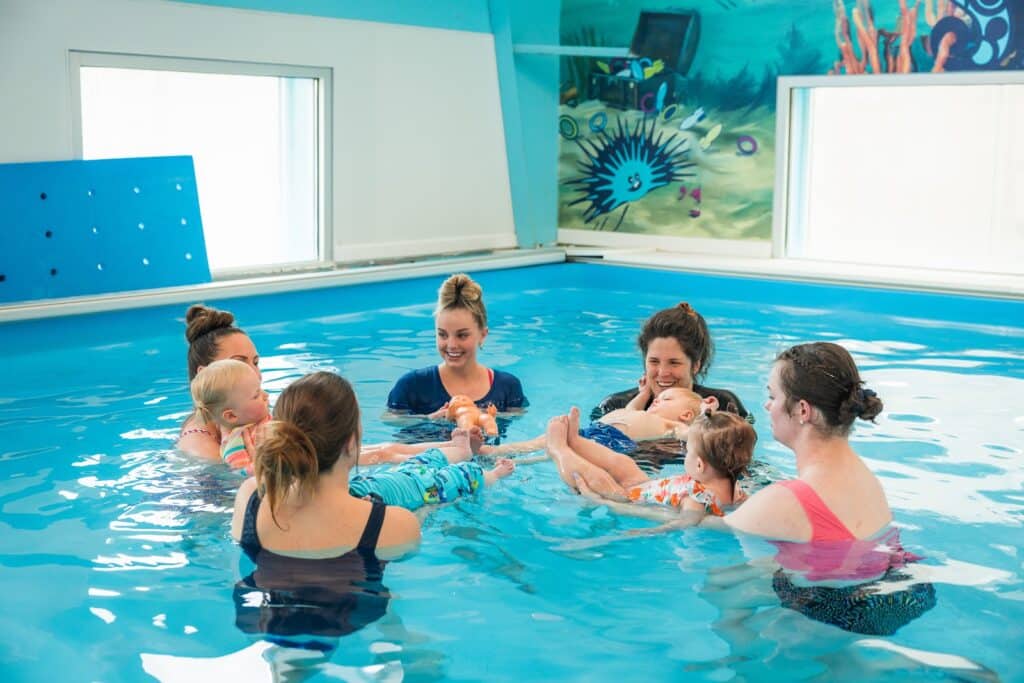
Four Months to 24 Months Old:
For infants and young toddlers, you can start swimming lessons as early as four months old! In fact, the American Academy Of Pediatrics (AAP) recommends babies to start formal swim lessons at the age of 1 to prevent drowning emergencies. Of course, the only safe way for babies to learn to swim is with 1-on-1 attention from a responsible adult.
Babies have a natural affinity for water, which means they are developmentally ready and will usually adapt more readily to the water at a younger age. Therefore, it is a completely safe practice to teach children this lifelong skill. Parent-tot swimming classes provide a fantastic opportunity for bonding while teaching infants basic water safety skills.
The repetition of weekly classes is also helpful for your baby’s development. Infants and young children thrive on routine and predictability, and repetition provides a sense of familiarity and security for them.
18 Months to Six Years Old:
This is the best time for children to start private, learn-to-swim lessons. You should start with swimming lessons designed to teach water safety and survival skills. Your child should learn how to hold his breath, float independently, and kick with his body in a prone position. Once he has mastered these skills, he can learn to put them together in order to swim-float-swim.
These essential skills allow your child to self-rescue if he were to unexpectedly find himself in an emergency. Therefore, you will drastically reduce his risk of drowning by enrolling him in a swimming program.
Children are not always initially excited about the hard work of swimming lessons. However, once they persist they will gain confidence in themselves and their ability to learn new and difficult things!
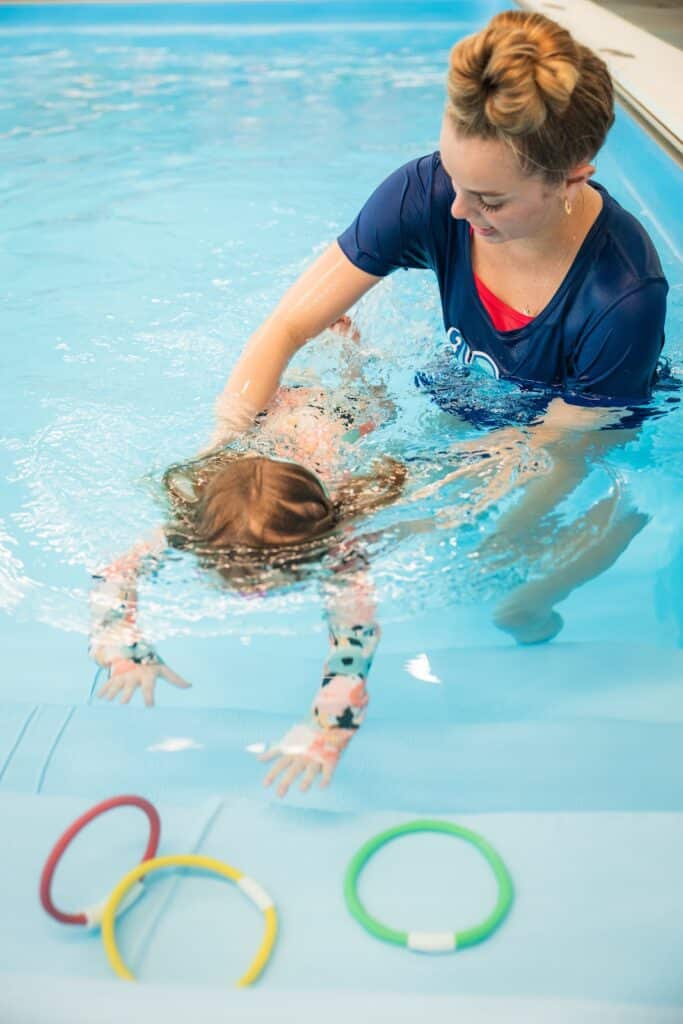
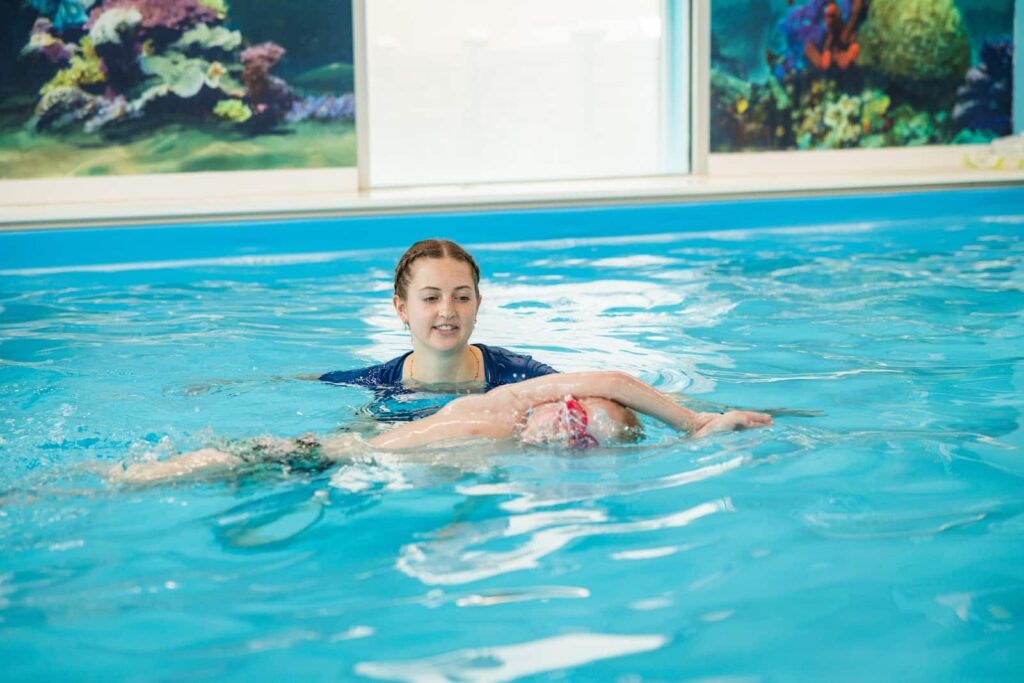
Four Years to Ten Years Old:
By this age, most children have the cognitive and physical skills they need to learn more advanced swimming techniques. Once this group has mastered basic safety skills, they will easily learn the four basic strokes: freestyle, backstroke, breaststroke, and butterfly.
Students are also able to learn flip-turn techniques and prepare to swim competitively. Once they are comfortable with basic swimming skills, they can join a group class. They will learn practical skills of social swimming and following instructions in an aquatic environment.
The biggest factor in determining the age for your child to start swim lessons should be water safety. Although there are many benefits to early swimming lessons, water safety is the most important factor. Additionally, you should consider each child and your family’s unique circumstances to determine what is right for you.
Additionally, it is vital to choose certified swimming instructors and facilities that prioritize safety and maintain a positive learning environment. Most importantly, it is never too late to get started. Knowing how to swim and feeling comfortable in the water is a life-long skill! As your children become safer and more comfortable in the water, you will enjoy playing and vacationing together even more!
If you live in Davis County, Salt Lake County, or Utah County check out our premium swimming lessons for kids! We offer parent-tot, learn-to-swim private lessons, and group lessons. Our facilities are located in Layton, Holladay, and Pleasant Grove. We offer year-round swimming lessons in a warm and inviting environment.
Ready to dive into fun? If you’re in Davis, Salt Lake, or Utah Counties, secure your child’s spot at SwimKids now! Click here to register and make a splash today!
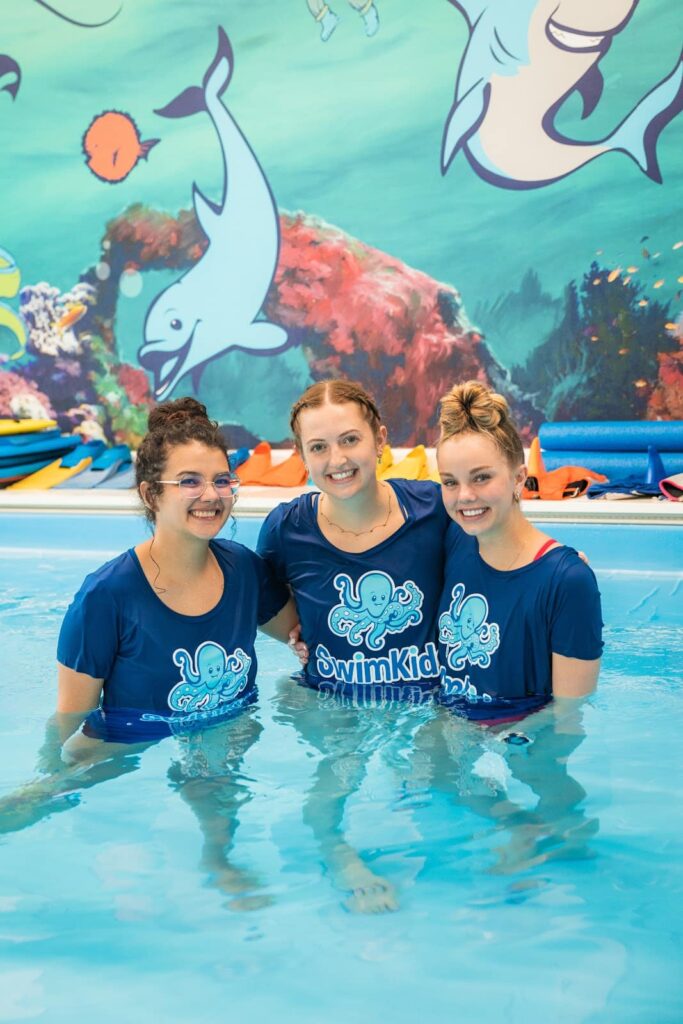
The Best Age to Start Swimming Lessons: Here’s Our Take
1. Water Safety
Swimming lessons teach children essential water safety skills, such as floating, swimming, and reaching the edge of the pool or shore. Swimming lessons should also teach children where it is safe to jump or dive. These skills enable children to explore and enjoy aquatic activities safely and with greater independence.

2. Drowning Prevention
Drowning is the second leading cause of accidental death among children. Therefore, it is essential to introduce children to swimming early. According to a study conducted by the America’s National Institute of Health, swimming lessons help children from 1 to 4 years old reduce the risk of drowning by 88 percent. Therefore, they’ll learn to enjoy and respect the water.
3. Confidence and Independence
Swimming lessons help children gain confidence and feel comfortable in the water. Numerous parents have told us how their child’s ability to interact with others, try new things, and enjoy school activities improved once they started swimming lessons.
4. Physical Fitness
Swimming is a great way to exercise year-round! Swimming is a non-impact exercise that promotes many health benefits, such as cardiovascular health, muscular strength, endurance, and flexibility.


5. Swimmers are Smarter
Swimming lessons help improve coordination, balance, and overall motor skills as children learn to move their bodies and hold their breath in water. The skills learned in swimming translate into the classroom as well! Children who learn how to swim at a young age reach many developmental milestones earlier than the norm. They may also perform better in skills such as cutting paper, coloring, drawing, math, oral expression, and literacy.
6. Improves Sleep
Swimming is a physically demanding activity that uses multiple muscle groups. Swimming provides a full-body workout and helps children expend energy, which can lead to better sleep.
Regular physical activity, including swimming, promotes better sleep patterns in children. It can help them fall asleep faster, improve sleep quality, and reduce the likelihood of sleep disturbances. Bonus if your kids come to lessons right before bedtime and can shower and change into their PJs before heading home 🙂
7. Stress Relief
While it might not seem that way in your first few lessons, swimming is known to be a relaxing and stress-relieving activity! As children learn to love the water, it is an environment that will help them unwind and improve their mental well-being. The sensation of being in water can have a soothing and therapeutic effect.
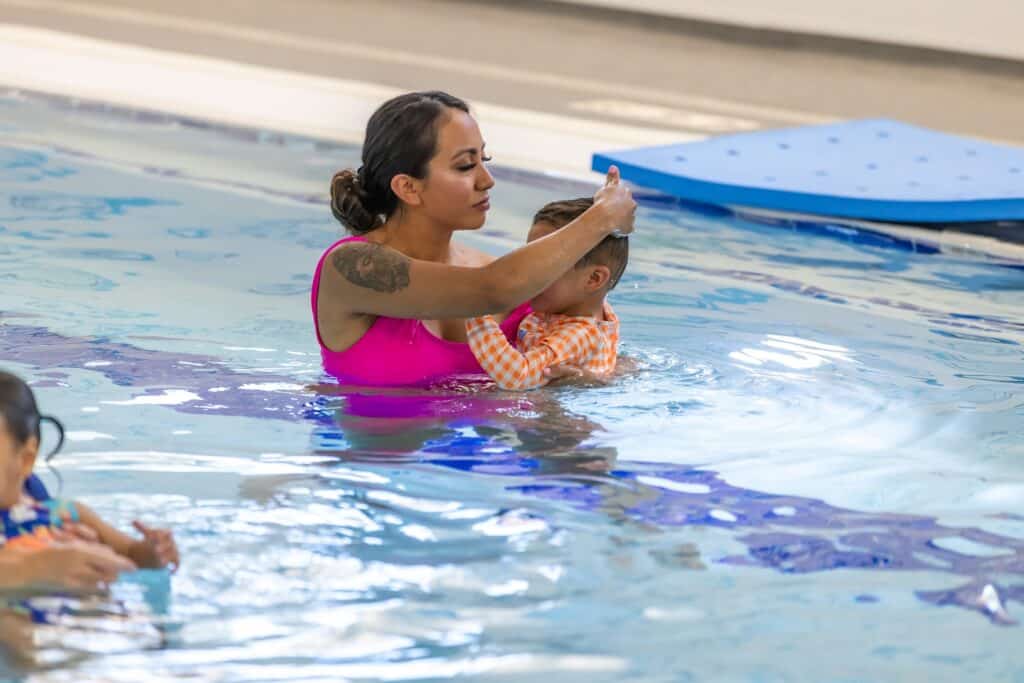
8. Lifelong Skill
Learning to swim is a valuable life skill that your child can enjoy throughout his/her lifetime. It provides opportunities for recreation, fitness, and safety. When your child has strong swimming skills , you can send them to parties or take them on vacation with confidence; they know how to safely enjoy the water. What other sport can you enjoy at 2 or 92?!
Ready to dive into fun? If you’re in Davis, Salt Lake, or Utah Counties, secure your child’s spot at SwimKids now! Click here to register and make a splash today!